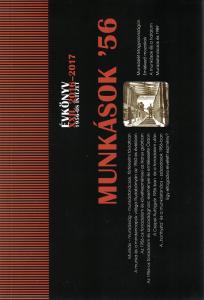
Workers ’56
Workers ’56
Edited by János Rainer M. and Tibor Valuch
NSZL–1956 Institute Foundation, Budapest, 2017., 260 pages
[Yearbook XXII. 2016–2017]
ISBN 977 121 678 546 3
ISSN 1216-7851
This Yearbook of the 1956 Institute contains the edited version of the presentations on the role of workers in the revolution, one of the most interesting topics of the 1956 and Socialism, Crisis and Rethinking conference. The multi-disciplinary conference of recent past history was held in Eger in September 2016 with the participation of several institutions.
The basic idea of the conference was that the 1956 revolution, one of the most significant events of 20th century Hungarian history, clearly indicated the crisis of Soviet-type systems. After October 1956 one could hardly think of Socialism the same way as before. At the same time also the everyday relation to Socialist dictatorships changed. The Hungarian 1956 was not an isolated event, it was part of an international process that started with the death of Stalin and continued for years more. This was the point of view from which the contributors of the conference wished to rethink the history of 1956 in Hungary. Is a non-Capitalist development even possible after that the classical bolchevique program lost credibility? Can Socialism be democratized; can the inequality of Capitalism be eliminated? What new sorts of adaptation were brought by the new function mechanisms?
The revolutionary role of the working class has always interested the analysts looking at 1956 also from a social history viewpoint. The central thought of the monograph by Paul Kecskemeti published in the United States in 1961 is that the “unexpected revolution” was triggered by the accumulated tension of many types of resentment in different strata and groups within the Hungarian society. Kecskemeti was the first author to give special emphasis to the working class apart from the intelligentsia, building greatly upon oral history interviews and questionnaires made with Hungarian emigrants.
Leading theorist of totalitarianism Hannah Arendt was also of the opinion that 1956 proved the possibility of a reasonable and spontaneous mass movement for freedom even in a Soviet-type totalitarian regime. Arendt saw in 1956 the revival of a lost tradition that started with the countryside district meetings of British North America and the 1789 Paris Councils of Commune, and continued with the Paris Commune of 1871 and the Soviets of 1905 and 1917. In her opinion the councils’ revolution is the hope of the modern world as opposed to the one-party (or multi-party) political systems that inevitably deform into totalitarian, dictatorial structures. The essays in this volume discuss on the highest professional level the antecedents and possibilities of a worker’s revolution in 1956 and the political and societal role of the working class in 1956 and beyond.
Shopping
Our publications are available in our bookshop, or can be ordered from the Publications Department of the NSZL using the contact details below: Főigazgatói Kabinet kiadványtára, Országos Széchényi Könyvtár, 1276 Budapest P.O. box 1205., phone: 06 1 232-3556, e-mail: kiadvanytar@oszk.hu.




